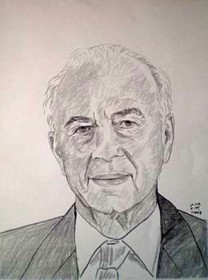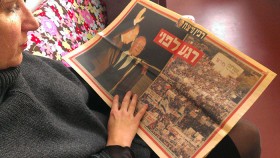Remembering 4 November 1995

Jitzchak Rabin, drawing by Chaim Topol
CC BY-SA 3.0, via Wikimedia Commons
Twenty years ago today, 4 November 1995, Israel prime minister, Yitzhak Rabin, was assassinated following a peace rally in central Tel Aviv. Mirjam Wenzel was there.
“It was a mild evening at Kikar Malchei Yisrael (Kings of Israel Square, now Yitzhak Rabin Square) in the middle of Tel Aviv, where throngs of people had gathered under signs of shalom achshav (peace now) to show their support for Rabin and Shimon Peres and their push for peace. The national religious movement had grown more hostile towards the government in recent weeks, and the media had been reporting its demonstrations with posters of Rabin in a SS uniform. No one could imagine, at least not within my circles, that this movement could turn deadly. From the Tel Aviv office of the Friedrich Ebert Foundation, where I had a semester internship, the Oslo Accords were viewed as a political and economic fact.
The peace rally wasn’t far from the foundation’s then office, and I took part – to support the government but more so to see Aviv Geffen perform. The dazzling and flashy pop star was viewed as a rebel by young people, proof that times had changed; Tel Aviv had become a global city and you could function in Israeli society even without serving in the army. I went home after Aviv Geffen sang Likvot lecha (To cry for you) – a song about mourning a friend that became a hymn for Rabin. Then I met a friend in a bar in Florentin. That’s where we learned of the assassination.
Every Israeli remembers where s/he was that evening and the national shock that followed. Everyone knew nothing would ever be the same again.”

Mirjam Wenzel saved a copy of the 5 November 1995, edition of the Israeli newspaper Maariv which was entirely dedicated to the Rabin assassination. The Hebrew over the photos of Rabin at the peace rally reads, “the moment before.”
CC-BY Jewish Museum Berlin, photo: Mirjam Bitter
Our somewhat younger Israeli colleague, Yaniv Feller, compares the memory of 4 November 1995, with a question for Germans: “Where were you when the Berlin Wall fell?” Not everyone was there or immediately knew what had happened, even if it can seem that way in retrospect. Yaniv was still in school in 1995 and recalls that evening:
“It was pretty late so I was already in bed reading a book before going to sleep. Maybe I was already asleep. My brother and father were in the next room watching football – Maccabi Haifa versus Beitar Jerusalem, I think. It was a typical Saturday night. The phone rang. It was my grandmother. Rabin had been shot, that was all anyone knew. My brother and father switched immediately over to the news. I also rolled out of bed and watched TV until late. Naturally, this was the talk of the school in the days to come. Looking back, Rabin’s assassination shaped my political consciousness, but it didn’t hit me right away. I wasn’t one of the ‘candle kids’ and didn’t go to the square then known as Kikar Malchei Yisrael.”
Mirjam still remembers the candles vividly:
“In the weeks after, thousands of candles burned on Kikar Malchei Yisrael, and there were always young people meeting to mourn together. The slogan, shalom, chaver (farewell, friend), was everywhere and Aviv Geffen’s song played nonstop.”
Aviv Geffen: “Cry for you,” live, one week after Rabin’s assassination
The assassination of Rabin wasn’t just a deadly attack on a charismatic politician but also on the vision of a peaceful resolution to the Israeli-Palestinian conflict. Now, 20 years later, the New Israel Fund (NIF) is hosting a panel discussion here in the museum about Rabin’s legacy and the role of democracy in civil society (more information on our event calendar). The memory of 4 November 1995 will surely come up in the conversation.
Mirjam Bitter gathered the recollections of Yaniv Feller and Mirjam Wenzel, and she looks forward to further reflections in the comments section.